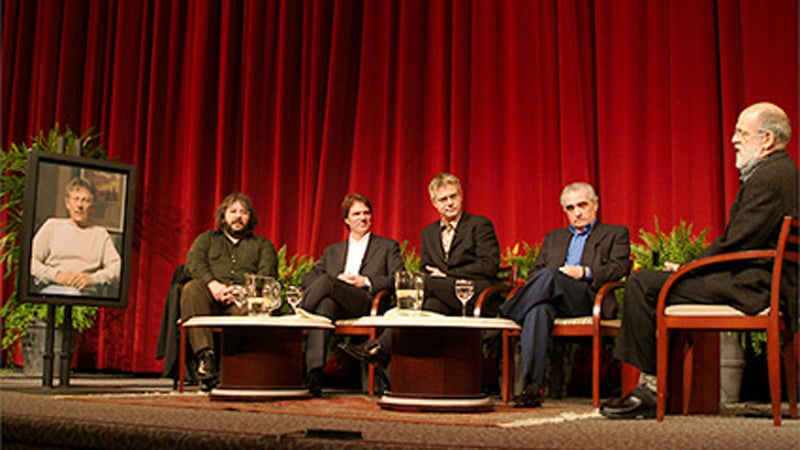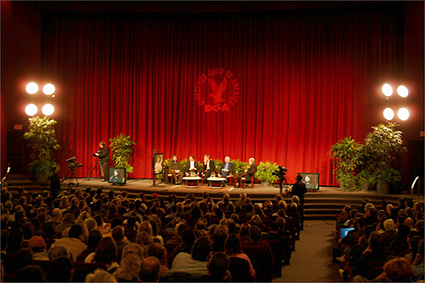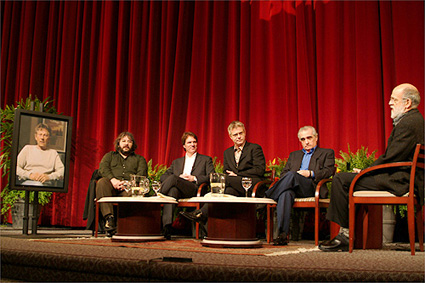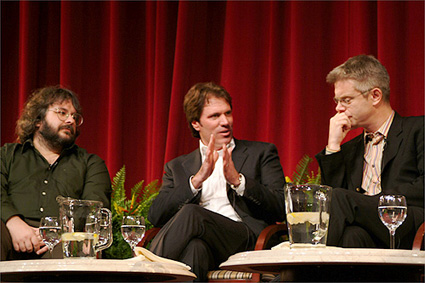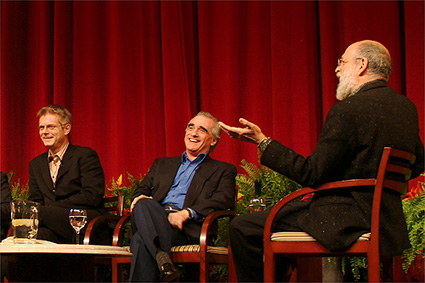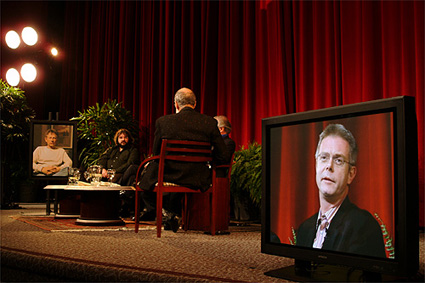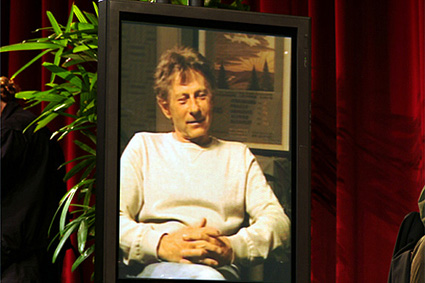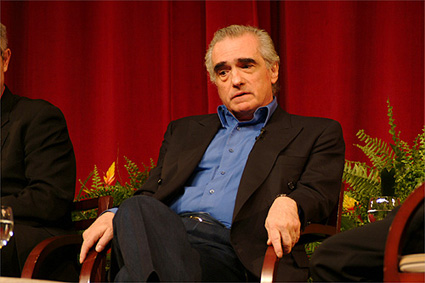All five spoke of their deep involvement in the shaping of their films' screenplays. Marshall, for example, brought to Chicago screenwriter Bill Condon the conceptual idea of using two worlds — the vaudeville world and the realistic world of 1920s Chicago — "but coming up with how and why we would go back and forth was something that we had to work out." The ultimate answer was to keep the point of view through Roxy Hart's eyes. Just as challenging was cutting out musical numbers; the first draft, he recalled, contained all of the stage version's numbers, some of which clearly had to go in order to maintain a reasonable running time. "It was hard, but at a certain point the script starts talking to you. It tells you: 'This can't stay because it doesn't forward the plot or the character.' Musicals don't work when you're just waiting for the next number." Chicago's 80-year-old themes of twisted celebrity, fame, and cynicism appealed to the director. "It hasn't changed. I remember saying to Catherine and Renée when we were shooting the final number, 'you have to imagine that this club act is like Monica Lewinsky and Linda Tripp, and the audience is laughing at you and they're loving it, because it's so irreverent.' "
Scorsese, too, found the themes of Gangs of New York to be timely. He was fascinated by both the survival of New York immigrants at the time of the story as well as the greater sense of survival of civilization itself, a subject, he said, that lends the picture great relevance today. But as the script evolved over many drafts and writers from the 1970s on, Scorsese's choices of what to emphasize in the script evolved too. "I was afraid that something that had been in my head for 20-odd years would be stale. So I kept changing it. I wanted it to be alive, to appear excessive, with everything falling out of the frame." By the 1990s, Scorsese was especially fascinated by "the anthropology" of the script. "For instance, what it would be like to go to a theater at the time, where the working classes expressed themselves politically... the rich people coming downtown to check out the poor... what boxing was like back then... But I never believed it was going to get made — even while they were building the sets!"On The Two Towers, Jackson's process was to hone the script through the entire filmmaking process. "Nothing is ever perfect, so you just keep working it and working it, every second of the day," he said. That meant rewriting during production (to the point of sliding script pages under Ian McKellen's door at 11:30 p.m., asking him to be on set at 6:30 a.m.) and even post-production. Jackson spoke strongly about his reliance on pickup shooting, telling how his team would watch a rough cut of the film and decide not just on new editing ideas but on the scenes that needed to be rewritten, re-shot, or even created from scratch. Jackson would then fly actors back to New Zealand for an additional 2-3 weeks of shooting. "Everyone got into the spirit. For every film I make in the future, I'm going to build in that period of additional shooting because it's such a valuable tool. You just organically develop the thing through to the very end. The filmmaking process is very fluid."
By contrast, Polanski said his script "had no pink, yellow, or blue pages at all. That doesn't mean you don't need pickups — you can't hit the bull's-eye on every shot — but you always try to be as close as possible. What's not on the paper will not be on the screen." After screenwriter Ronald Harwood wrote the first draft adapted from Wladyslaw Szpilman's book, he and Polanski spent more than a month in a country house near Paris working 14 hours a day, rewriting and shaping the script: "I used my own recollections [of life in the Warsaw ghetto] to illustrate things that in the book were only ideas." This meant transforming events into pure film language in terms of the staging, the look, and specific locations. Polanski and Harwood also went through massive amounts of archival material. "The Germans loved filming their 'work,' " Polanski noted wryly. "It was quite painful [to watch] — much more painful than the shooting where you're dealing with costumes and actors." Even so, during shooting, he recalled, "I would find myself sometimes in the middle of a scene where it all looked so real that I had to pinch myself to say it's only a movie."
Daldry was attracted to The Hours because "it's about the difficult choices people have to make in their lives, and more importantly, the cost of those choices." He echoed Jackson's remarks about the value of pickup shots, recalling how eight months after production he brought back Meryl Streep and Claire Danes to re-shoot part of their scene in a bedroom. He marveled that a series of shots in this delicate sequence were filmed so far apart and yet the performances were so smooth. "Meryl's such a genius at being able to do this extraordinarily complex emotional rhythm and capture it exactly as she did a year ago." On the subject of casting, all five directors agreed that finding the right actor often comes down simply to a gut feeling. Polanski, for instance, after auditioning dozens of hopefuls for the character of Szpilman, finally met Adrien Brody. They talked about the script, and without asking Brody to read, Polanski knew he had found his leading man. "It just felt right," he said. Scorsese, too, remembered that in Cameron Diaz's first audition with Leonardo DiCaprio, "something happened. She made it very clear who the person was. And I saw something happen in him." Watching this "magic" unfold between actors firsthand, Scorsese said, is one of his favorite moments directing.There were too few dialogue scenes in The Pianist to warrant much rehearsal, but when Polanski does rehearse, he lets the actors find their own natural staging. "It's like having a terrific suit made by a great tailor and then trying to look for the guy that will fit in it. I do it the other way around. I believe that the actors instinctively take the right places in the situation. They, of course, desperately ask for instruction, and I try to cheat them out of it, to coax them so they do it themselves. Then I intervene and shape it. In a certain sense, it's sort of a documentary approach." Daldry employs a similar method, letting actors' movements dictate the ultimate frame rather than vice versa. Daldry also quipped that in dealing with actors, a director should "never, ever underestimate the power of flattery."
In casting a musical, Marshall said he prefers actors who are new to the genre "because they don't come from a technical [dance] place. It's so important to cast the character first." Instead of auditions, Marshall held "work sessions. It's very important for me that people don't feel judged. I hate auditions for that reason. I like actors to feel protected so they can try things they wouldn't normally try." He devoted six weeks to rehearsals, focusing primarily on the musical numbers, and even rehearsed a script reading, which he then staged in front of a large audience. In addition to helping his stars confront their fears of singing in front of many people, the reading gave his team "a sense of how everything played, what was too long or too short. Everybody got a sense of the whole and how they fit into it, and they felt really strong and confident afterward. To me, [directing actors] is all about positive reinforcement — to make them feel safe enough to try things."For Scorsese, "rehearsal became about body language. There's a certain body language that's hostile — the proximity, how close a person is to you. You can't tell an actor that, but they have to really understand it, and what the consequences would be if they're too close to a person."
In shooting big action scenes, Jackson often used 3-4 cameras, which he planned in advance by the use of models. He didn't rely too heavily on storyboards, finding them "a little bit useless in that unless you've actually built the set or found your location, and you know exactly what the geography is, you're kind of just making it up." In the editing stage, Jackson said, "I tried to create a little story in the battle. I didn't want it to be a cacophony of action; I wanted people to be able to follow what was happening, to be aware of the different strategies. We found that the battle scenes became uninteresting if we cut away from our principals for too long. So when we had two or three shots without one of our leads, [cut] back to the lead." Scorsese, on the other hand, relied on storyboards a great deal. They included all camera moves because he envisioned the film as a whole "moving a certain way." The battle scenes in Gangs were a huge undertaking. "The last one was done with seven cameras pretty much in one day. I had three units going, and I'd just go from unit to unit on a golf cart." Scorsese also looked at a number of classic films before shooting, citing in particular the films of Hitchcock, Lean, Polanski and Eisenstein. "Subconsciously, you pick up things." From Potemkin, for example, Scorsese studied how to build large action scenes through the editing of "bits and pieces in close-up." On the subject of video assist, Daldry said, "On a film like The Hours, video assist is useless, so you tend to just look at the actors live, or through the lens." He also said he likes to shoot many takes just to see what else might occur in a performance, and whenever possible, to keep rolling the camera between takes in order to avoid the long delays of doing hair and makeup again. The other directors chimed in their agreement on this."For a director, the most difficult part of filmmaking is to stick to his initial imagination," Polanski said. "I find it very important to close my eyes sometimes and recall what I had in my mind before I started this whole adventure, and try to be as faithful to it as possible. When I'm on the set, sometimes I have arguments because I ask for a little detail to be on the left and not on the right, and people don't understand why. To them it seems all the same. But to me it's very important, the way I have thought of it." On The Pianist, Polanski constantly kept in mind the strong subjective story structure of his film. In the many sequences of Brody looking out the window, for instance, he "had to be very precise in terms of what to show. I had to give the impression that it could be seen from the window — but in reality the camera was much further out." For the powerfully realistic image of Nazis driving a jeep over injured Jews lying in the street, Polanski explained that he placed stuntmen in holes on either side of dummies, with their arms and legs exposed. When the jeep ran over the dummies, the stuntmen moved their limbs. "I love every bit of directing," said Polanski. "We are very lucky people to do this, and to have this passion."
